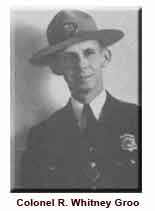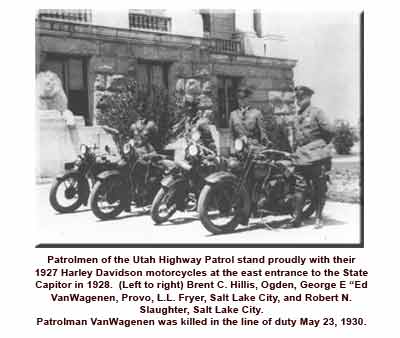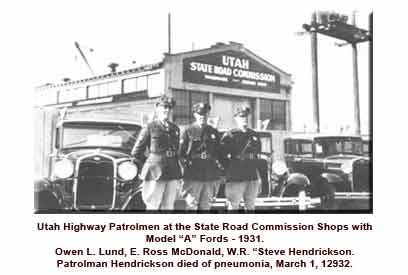State Road Police
By authority of the 1923 Utah Legislature, the State Road Commission was “to divide the State highways into sections for the purpose of patrolling and policing the same and to employ persons to patrol or police the said highways as may be deemed necessary in the judgment of the Commission.” (Utah Road Law of 1923, Chapter 61, 2852, paragraph (o), effective April 1, 1923.)
The State Road Commission then authorized the chairman and a number of the engineering staff to carry badges and to “serve as special traffic police.” The Chairman of the State Road Commission from 1921 to 1925 was Preston G. Peterson of Provo, Utah. He was a devout Republican and was appointed by Governor Maybe. The other Republican member of the Commission at that time was Henry Lunt of Cedar City. When Dern, a Democrat, became Governor of Utah in 1925, Henry Blood was appointed Chairman of the Commission along with democrat William Parker. Preston G. Peterson stayed on as minority member of the Utah Road Commission until his removal in 1941 by Governor Herbert Maw. From 1927 to 1941, Preston G. Peterson served as the de facto member of the Commission assigned to oversee the Utah Highway Patrol.
n 1925, R. Whitney Groo was given the assignment to organize these special traffic police into “patrols.” Whitney Groo had accepted employment with the Utah State Road Commission in 1918 as an engineer for road construction. The Tenth Biennial Report of the State Road Commission issued in July 1928 states, “A state road police patrol has been established on the most heavily traveled roads, to cooperate with local authorities in the enforcement of traffic regulations. Five police are all that are employed by the state at the close of the biennium and while this service is in its infancy much effective work has been done.” The report continues, “The first attempt at highway patrol work for the enforcement of traffic regulations was made in 1925 when two officers were employed on a part time basis.” (Note: Italic added by the author of this article.)
Groo hired two part-time officers, Robert N. Slaughter and Ray Deming in 1925. These officers were designated as Patrolmen. The badge authorized by the State Road Commission and issued to these patrolmen consisted of a silver shield with the words “STATE ROAD COMMISSION” on the top and “POLICE” on the bottom. In the center of the shield was a five point star. The words “OF UTAH” followed by a number in the center of the star depicted the division of the State Road Commission where the officer was assigned.
The Commission was extremely concerned with traffic accidents at intersections. On April 16, 1926, Slaughter was moved to full-time status to help alleviate this problem. On May 5, 1926, the State Road Commission adopted a regulation requiring vehicles to stop before entering arterial highways, heavily traveled roads. The following day, the first “arterial highway” was designated from 9th South in Salt Lake City to 5th North in Provo. The standard stop sign was placed at all intersecting streets to this, the first “modern” highway in Utah.
Patrolman Slaughter’s duties included enforcement of this new regulation. Many of the general public considered this new regulation an infringement into their lives and another example of government intervention. Patrolman Slaughter was kept busy trying to educate the public that this regulation was enacted to protect them from harm and accident.
Ray Deming was moved to full-time status on July 1, 1927. Three additional patrolmen were hired in 1928, as follows: George E. (Ed) VanWagenen, April 11, 1928; Lathael Lawrence Fryer, April 16, 1928; and Brent C. Hillis, May 1, 1928. Annual reports of the State Road Commission refer to this organization as the “state road police patrol.”
Three more patrolmen were hired in 1929, bringing the “state road police patrol” to a total of eight officers and one administrator. The annual operating budget of the patrol for 1929 was $11,743.06. The following year, no new patrolmen were hired. Robert N. Slaughter left the patrol on December 1, 1930. Peter L. Dow was hired on March 15, 1931, to replace Patrolman Slaughter. The 1931 legislative session recognized the need to hire more patrolmen to provide statewide protection and authorized the hiring of six more patrolmen.
These officers were called “patrolmen” and were issued a forest green dress blouse and motorcycle pants. An insignia of a motorcycle wheel with wings was sewn onto the left sleeve approximately 9 inches below the shoulder. By the early 1930s, this insignia was sewn onto both sleeves. A rigid, circular hat was also adorned with this insignia. A daily-wear uniform was also issued which consisted of a khaki long sleeve shirt with black bow tie and khaki motorcycle pants. Black, knee-high leather boots were issued. Besides being attractive, they protected the officers’ legs from the heat and flying oil from the motorcycle engine. It was necessary to use boot hooks to get the boots on and a boot jack to get them off.
These patrolmen were issued 1927 Harley Davidson motorcycles with a side shift lever and foot clutch. These early Harleys had exposed push rods and valve rocker arms. A red spotlight was mounted on the left handlebar with a white spotlight mounted on the right. A siren was also added. Within a few years, a first aid kit was mounted to the rear fender. In the 1920s, all Harley Davidson motorcycles were painted a dark color, usually a dark green or olive drab. The patrol did not repaint these bikes for several years. By 1931, the patrol repainted all issued motorcycles white with “Utah Highway Patrol” stenciled on the gas tank.
Patrolmen were also issued 1928 Model A Fords with dual carburetors which were capable of obtaining speeds of 60+mph. Patrolmen were instructed to operate the fuel efficient motorcycles whenever possible and only drive the Model A Fords during inclement weather. Speeds were limited to 35 to 40 miles per hour on gravel roads, outside of urban areas. High speed chases of 55 to 60 mph were considered really flying on these twisting, narrow, gravel roads. Most vehicles built during the 1920s were not capable of speeds greater than this.
The wages for these patrolmen were $140 per month, which was a fairly good salary for 1928. There were no training schools for state patrolmen, because all of the other states were organizing their patrols at approximately the same time. A few of the early members of the patrol had some military background. Therefore, some of the first training was in close order drill, military courtesy, proper dress, and uniform care. With no communications and the passing of only an occasional motorist, patrolmen learned to solve a variety of problems on their own. Being a peace maker, politician, doctor, nurse, mechanic, tour guide, marriage counselor, and big brother were all duties required of patrolmen.
This new breed of police officer spent many hours on their Harley Davidsons, much like the lawmen of the 1800s, who spent time on their horses. Time meant little to these modern peace officers. They worked six days a week and sometimes seven if they were called out. They simply had a job to do and they did not worry about overtime hours or compensation. Dedication, pride, and commitment were synonymous with being a state patrolman.
Due largely to few paved roads and no driver education for the general public, accidents were common during the early years of the patrol. Shortly after his appointment to the Patrol, Ed VanWagenen was on routine patrol on Canyon Road near Provo. Upon rounding a sharp curve, he discovered a vehicle being driven on the wrong side of the road, headed directly toward him. Instinctively, Patrolman VanWagenen swerved to the right to avoid a head-on collision. He ran off the right side of the road, skidded down an embankment and through a barbed wire fence. The left handlebar of his motorcycle struck a fence post, cutting off the index finger of his left hand. The vehicle which caused the accident failed to stop.
Patrolman VanWagenen dragged his damaged Harley Davidson motorcycle back onto the graveled road, retrieved his finger from the barrow pit, and drove himself to the Aird Hospital. Doctors at the hospital attempted to graft the finger back to his hand. The operation was not successful, and a few weeks later the finger had to be removed. Despite this serious injury, Ed never told his children. His son Everett, then age 13, stated that one day he noticed his father’s finger was missing. He was shocked when he first learned about his father’s experience three or four months after the accident.
By June 30, 1928, Utah had 3,436 miles of state highways. Only 1,406 had been graded, 1,444 miles had been graded and graveled, and 275 miles had been surfaced, leaving 611 miles to be improved. (Governor Dern’s, message to the 1929 legislature.) Gasoline tax was 3 1/2 cents per gallon. Roads through incorporated areas were constructed, financed at an 18 foot width; however, municipalities could provide for extra width and curb and gutter by providing additional funding. During the following years, an aggressive paving program was implemented and by the end of 1929, an additional 129 miles of road were oiled. These improved roads transported the many products of a growing and mobile society propelled by automobiles capable of greatly increased speeds. For the first time in history, common citizens became possible law violators, and careful observance of highway signs and signals was made a legal requirement in order to protect the general public from traffic accidents.
Late in 1929, the following entry is found: “It was finally agreed by the State Road Commission that four additional patrolmen be employed with the understanding that when employed, it shall be with the knowledge that the position is not permanent, the salary to be $140 per month, and the Equipment Engineer instructed to request the Finance and Purchase Department for quotations on Harley-Davidson and Indian Motorcycles.”
The Patrol had approximately one patrolman for every 572 miles of state road. Patrolmen were stationed throughout the populous areas of the state where the heaviest traffic existed. The remoteness of many state roads, made officer safety a concern. In 1929, the following minute entry was recorded: “It was finally agreed that firearms should be carried, but particular pains were taken to impress upon the men that the Commission is anxious that they be not used unless it is absolutely necessary to protect the patrolmen’s lives ….” The weapons issued were Smith & Wesson, .44 caliber revolvers, with six inch barrels. The weapons were held securely in place in a cross-draw holster. A large metal loop, located inside the holster, attached to the trigger guard when the weapon was holstered. A patrolman would have to press down and out on the revolver prior to drawing the weapon. The holster also featured a large leather flap which further secured the weapon.
Due to the depression of the early 1930’s, the state of Utah increased road construction as a means of providing employment to thousands of men. Furthermore, strenuous efforts were being made to control the dust nuisance on the main highways. In 1931, 372 miles of roads were paved; 260 miles were paved in 1932. This mileage is probably the all-time record of oiled road construction in Utah’s highway history. It represents twice the amount of this type of construction completed in any other two years.


